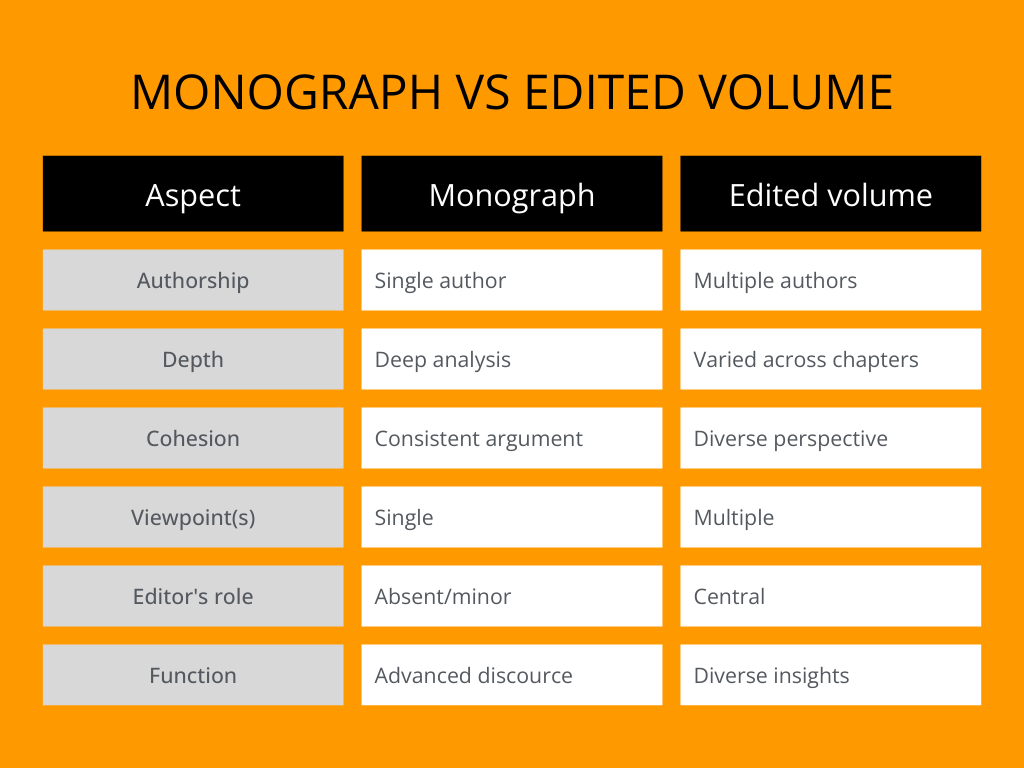A monograph is a detailed written study on a single specialised subject or aspect of a subject, often by a single author. It provides comprehensive analysis and is typically longer and more in-depth than an article, focusing on a narrow area of research or a specific topic. Monographs are common in academic and scholarly fields, where they are published as books or lengthy reports.
- Monograph names
- Monograph vs edited volume
- Writing a monograph
- Publishing a monograph
- Using editing services to finalise a monograph
What else is a monograph called?
A monograph may also be referred to by other names depending on context. Some alternatives include a dissertation or thesis, scholarly book, research study or a treatise.
In academic settings, a dissertation or thesis is similar in form to monographs but are typically submitted as part of degree requirements. In turn, scholarly book often refers to a book-length work in academia. A research study emphasises the investigative or analytical nature of the monograph. Finally, a treatise is a formal, systematic discourse on a subject, often used in legal, philosophical or scientific contexts.
What is the difference between a monograph and an edited volume?
The key difference between a monograph and an edited volume lies in authorship and structure. A monograph is written by a single author (or sometimes a small group of authors). Furthermore, it presents an in-depth, unified analysis of a specific topic or research area. The content is cohesive and develops a single argument or perspective throughout the work.

In turn, an edited volume consists of chapters or essays written by different authors, usually around a common theme or topic. The work is compiled and organised by one or more editors, but the individual chapters may vary in perspective or focus, as each contributor brings their own insights.
Writing a monograph in 10 steps
Writing a monograph involves a systematic process that demands thorough research and a focused, cohesive argument. Here is a step-by-step guide to writing a monograph:

1. Select a specific topic
Choose a narrowly defined subject that you can explore in-depth. At the same time, ensure the topic has sufficient academic interest but is not too broad to cover exhaustively in one work.
2. Conduct thorough research
First, review relevant literature and sources. Next, gather primary and secondary data if necessary. Overall, make sure your research is detailed and well-supported by existing scholarship.
3. Formulate a clear thesis
Develop a central argument or hypothesis to guide your monograph. This should form the backbone of your work and give it a clear direction.
4. Create an outline
Organise your research and ideas into a logical structure. Typical sections include:
- Introduction introduces the topic, background, research questions and objectives.
- Literature review summarises and critically evaluates existing scholarship.
- Methodology describes how you conducted your research (if relevant).
- Main body (chapters) presents the argument, analysis or findings in a coherent flow.
- Conclusion summarises your findings, restates the significance of the study and suggests further research.
- References list all sources cited.
5. Write the introduction
Clearly introduce your topic, explain its significance and outline the structure of your monograph. Do not forget to state your research objectives and central argument.
6. Develop the body
Organise the body into chapters or sections where each chapter should focus on a particular aspect of your research. Maintain a logical flow between chapters, ensuring each one builds on the previous argument.
7. Present evidence and analysis
Use data, citations and examples to support your argument. At the same time, critically engage with existing scholarship, showing how your monograph contributes to the field.
8. Write the conclusion
Summarise key findings and restate the importance of your work. Finally, suggest avenues for future research or unresolved questions.
9. Edit and revise
Review for clarity, coherence and academic rigour. Ensure your writing is well-structured and your arguments are clearly presented. Finally, edit for grammar, spelling and style consistency.
10. Format and submit
Follow the required formatting guidelines, if applicable (e.g. referencing style, citation formats). Remember to proofread your final draft before submission or publication.
Publishing a monograph
Publishing a monograph involves several stages, from preparing your manuscript to selecting the right publisher and ensuring it meets their requirements. Here is a step-by-step guide on how to publish a monograph:
1. Finalise the manuscript
Ensure your monograph is complete, thoroughly edited and polished. Address any feedback from peers or supervisors. Next, format the manuscript according to the publisher’s guidelines, if known. Include all necessary sections, such as title page, table of contents, references and appendices.
2. Identify a suitable publisher
Most monographs are published by academic presses (e.g. Cambridge University Press, Oxford University Press) or for-profit academic publishers, such as Elsevier or Brill. In any case, look for publishers that specialise in your field of study.
3. Prepare a book proposal
Most publishers require a formal proposal, which typically includes:
- Abstract: A concise summary of the monograph.
- Table of contents: List of chapters and subheadings.
- Sample chapters: Typically, one or two chapters to showcase your writing and argument style.
- Market analysis: Explain the academic and commercial potential, target audience and the gap your monograph fills.
- Comparative works: Discuss other works in the field and how your monograph differs or complements them.
- Author bio: Highlight your academic background, qualifications and expertise.
4. Submit the proposal
Follow the publisher’s submission guidelines, which are often available on their website. Some publishers accept unsolicited proposals, while others only accept submissions through agents or in answer to calls for proposals. Send your proposal to the appropriate commissioning editor for your subject area.
5. Peer review process
If the publisher is interested, they will typically send your manuscript or proposal for peer review. This is an external evaluation by experts in your field to assess the quality, originality and contribution of your work. Next, be prepared to receive feedback and make revisions based on the reviewers’ comments.
6. Revise and resubmit
Address the feedback from peer reviewers, editors or the publisher. Revisions may involve restructuring parts of your monograph, clarifying arguments or updating references.
7. Final approval and contract
Once the manuscript is accepted, you will receive a publishing contract. Review the contract carefully for rights, royalties and distribution terms. Make sure you understand what rights you are granting to the publisher and any financial arrangements, such as advances and royalties.
8. Production stage
After the contract is signed, your manuscript enters the production phase. This includes:
- Copyediting: The manuscript is edited for grammar, consistency and style.
- Typesetting: The layout and design of the book are finalised.
- Cover design: The publisher will design the book cover and consult with you for approval.
- Proofreading: You will receive proofs to check for any final errors before printing.
9. Marketing and distribution
The publisher will handle the marketing and distribution of your monograph, including sending review copies to academic journals, listing the book on their website and making it available through various platforms. You can also promote the monograph through academic conferences, social media and networking within your field.
10. Publication
Once everything is finalised, the monograph will be printed or made available digitally, depending on the format. Post-publication, the publisher may offer limited promotional support, and you may need to continue promoting the work within your academic network.
How can professional editing services help prepare a monograph for publication?
Leveraging professional editing services to prepare a monograph for publication can significantly enhance the quality, readability and impact of your work. Here’s how to effectively use these services:
Choose the right type of editing service
There are various levels of editing services, each suited to different stages of the writing process:
- Developmental editing focuses on the overall structure, argument and organisation of your monograph. This is ideal early in the process to refine the manuscript’s flow and coherence.
- Line editing is a detailed review of content, checking for clarity, consistency and logic. The editor may suggest improvements in phrasing, argumentation flow or chapter transitions.
- Copyediting concentrates on grammar, syntax, spelling and style. This ensures that the writing is clear, consistent and free of errors.
- Proofreading the final stage of checking for typographical and minor errors before submission or publication.
Find a professional editor experienced in your field
Look for editors who have experience working with academic or scholarly monographs in your subject area. For instance, academic publishers often recommend specific freelance editors or agencies with expertise in preparing scholarly works. Check credentials, reviews, professional affiliations or ask for recommendations from peers, institutions or academic networks.
Communicate your goals and expectations
Clearly outline your goals for the monograph, including your target audience, main argument and the areas where you feel the manuscript needs improvement. Moreover, provide any specific guidelines from your publisher regarding formatting, citation style or word count limits. Finally, share your timeline and any deadlines for the submission or revision of the manuscript.
Request a sample edit
Before committing to a full edit, consider asking for a sample edit of one chapter or section. This will give you a sense of the editor’s approach and whether it aligns with your expectations. A sample edit allows both you and the editor to establish a working relationship and confirm the scope of the work.
Incorporate feedback thoughtfully
After receiving the edited manuscript, carefully review the editor’s comments and suggestions. Engage with the feedback constructively, especially if it involves significant changes to structure or argument. Consider how the proposed revisions could improve the clarity and impact of your work.
Benefits of using professional editing services
- Improved readability: Copyeditors can make your monograph more accessible without sacrificing depth or scholarly rigour.
- Stronger argumentation: Developmental editors can help refine your argument, ensuring clarity and logical progression.
- Compliance with publishing standards: Copyeditors can ensure that your manuscript meets the formatting and citation guidelines of the publisher.
- Enhanced credibility: A well-edited and proofread monograph reflects professionalism, enhancing its reception among academic peers and increasing its chances of acceptance for publication.
Key takeaways
In conclusion, when asking what is a monograph, think about it as a publication offering an in-depth examination of a specialised subject. Distinguished by its singular focus and cohesive argument, it differs from an edited volume, where multiple perspectives contribute to a broader exploration of a topic. Writing and publishing a monograph involves careful planning, thorough research and adherence to academic standards. From choosing a topic to navigating the publishing process, every stage requires precision and dedication. Utilising professional editing services can further ensure the monograph meets scholarly expectations, enhancing its quality and impact within the academic community.
If you are an academic author looking for editing or indexing services, contact me. I am an experienced editor, and I offer a free sample edit and an early bird discount.


